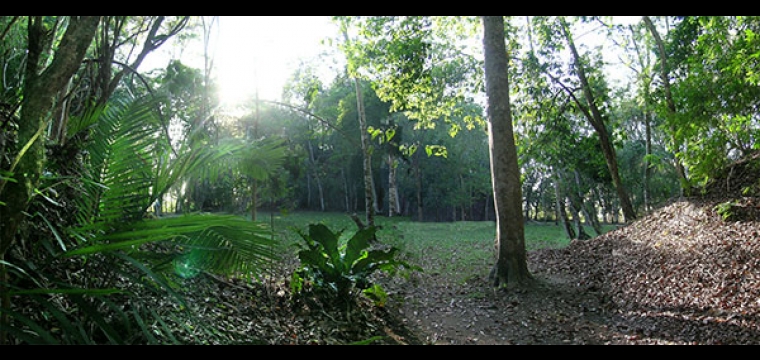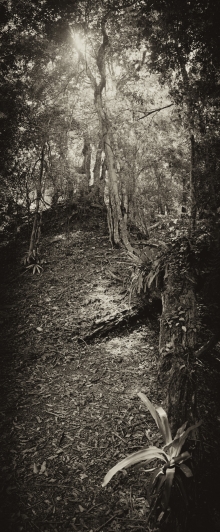Hover over the image to see El Pilar's potential
The very recent discovery of El Pilar offers the opportunity to pursue a different kind of conservation and management strategy called Archaeology Under the Canopy, where the natural forest and surrounding environment of the monuments are maintained to protect the site’s fragile structures from the elements. Recognizing that the natural environment is as much a relic of this grand civilization as the monuments themselves, we encourage a respectful integration of culture and nature. We have enlisted the support of experts from the likes of the New York City Botanical Garden and the Wildlife Conservation Society to help design a truly historical ecological park that integrates the past, present, and future influences of humans and cultural components on the natural world.
El Pilar differs from the conventional sites of the ancient Maya world in that it does not flaunt monumental prowess with cleanly exposed stone structures. In fact, most of the ancient structures still lie in shade under the forest canopy protected by vegetation. El Pilar is the subject of a whole new kind of archaeological presentation which still displays the history and impressive architectural achievements of the ancient Maya while encouraging an alternative focus that differs from other sites: the environment, life ways, and living culture of the Maya people. It will prove to be a model for projects to come, informing future solutions for how humanity can sustain itself and flourish by cooperating with nature instead of dominating and destroying it.
This philosophy also protects the integrity of ancient structures from external elements. Living biofilms attack the limestone where exposed, which rapidly deteriorates the vulnerable limestone facades. It is tree cover that reduces exposure to sunshine and rain and maintains an even temperature that will preserve the monuments. The ancient monuments of El Pilar are protected by their natural habitat from damaging wind, rain, and acid-producing bacteria. The pursuit of Archaeology Under the Canopy maintains the holistic vision of the site and ensures stability of temperature, humidity, and precipitation – factors that can quickly erode delicate plaster walls and elaborate facades. Experimentally, this method serves the needs of archaeologists while experientially furnishing the visitor a more conscientious encounter with the ancient Maya.
Research at El Pilar centers on settlement patterns, environmental management, and the everyday people of the Maya civilization. Partial exposure offers glimpses of the monumental architecture while highlighting the incredible biodiversity of the Maya forest. Whereas many monuments hint at the lives of the ancient Maya elite, the fully excavated and consolidated house site, Tzunu’un, evokes everyday Maya life.The ancient house compound provides a tangible experience of the home, and is surrounded by its own forest garden.
Everyday Maya life can still be experienced in the surrounding villages of El Pilar, where the rich cultural heritage of the Maya people has been maintained over centuries of change. The management model at El Pilar incorporates this community, leading to a rewarding collaboration with the stewards of Maya culture: traditional Maya farmers. They are known as “forest gardeners” because their agricultural techniques actually encourage biodiversity and foster the growth of the forest. With a focus on the everyday Maya people, The El Pilar Archeological Reserve for Maya Flora and Fauna is a living classroom where tourists, locals, and researchers alike are learning to understand the significant relationship between the modern world and natural agroecology. By introducing the practice of Archaeology Under the Canopy to Maya sites, we can demonstrate the grandeur of the Maya, protect the monuments for posterity, and shade the visitors who will enjoy a personal experience in the forest garden just as the traditional Maya once did.
At El Pilar in Belize and Guatemala, most of the major architecture has been mapped by traditional archaeological survey methods, but new structures are being uncovered by LiDAR, a piece of groundbreaking technology that enhances discovery while encouraging the philosophy of Archaeology Under the Canopy. LiDAR—Light Detection And Ranging — has been in the news as an accurate and detailed image-generating technology that can reveal long-lost archaeological sites. LiDAR data has allowed researchers to locate immense sites hidden in the lush forest.


